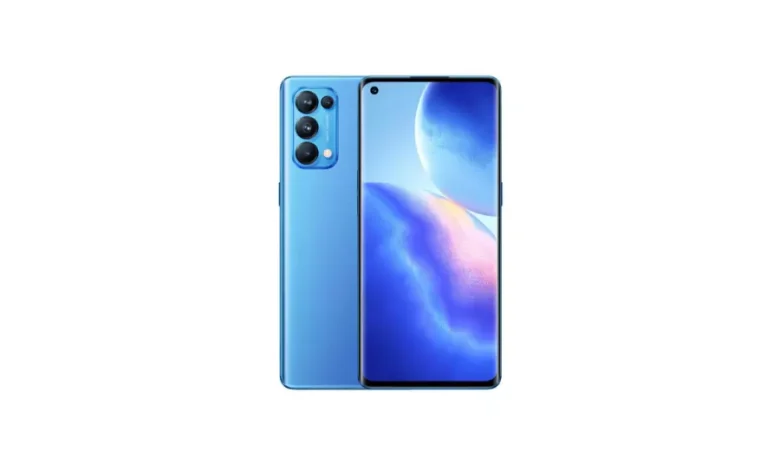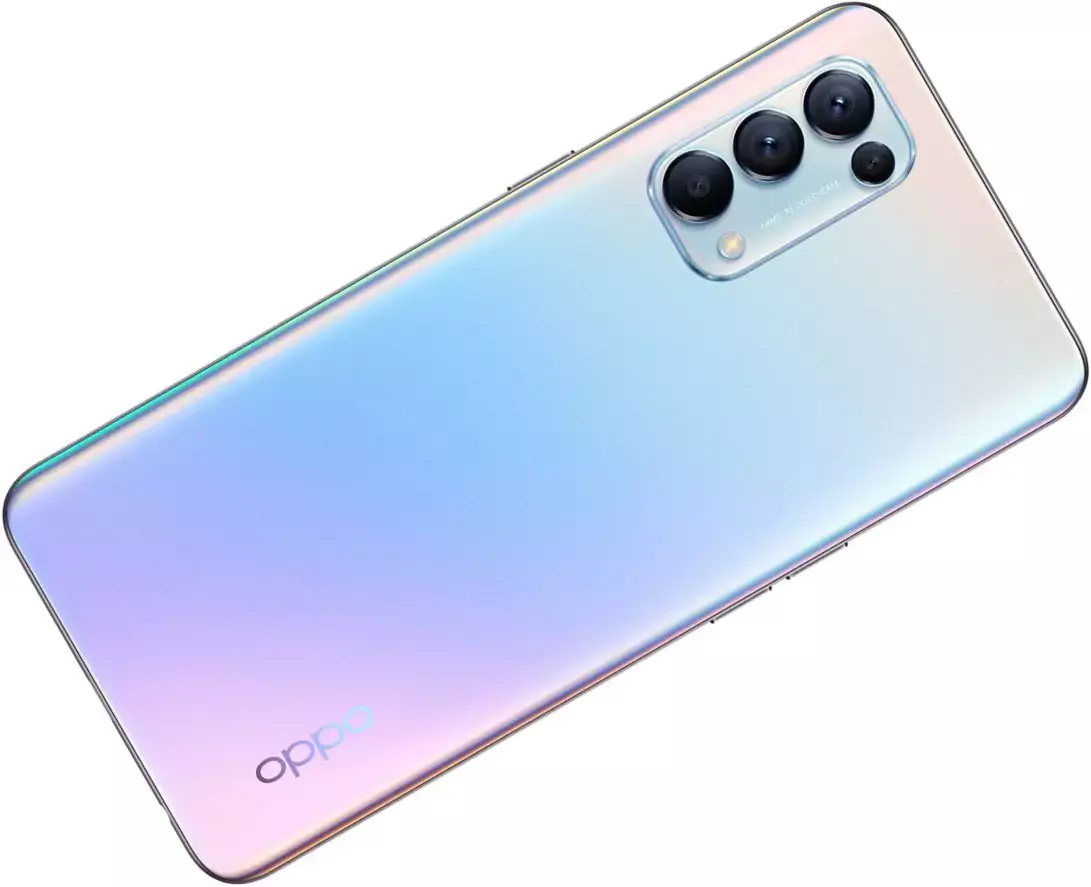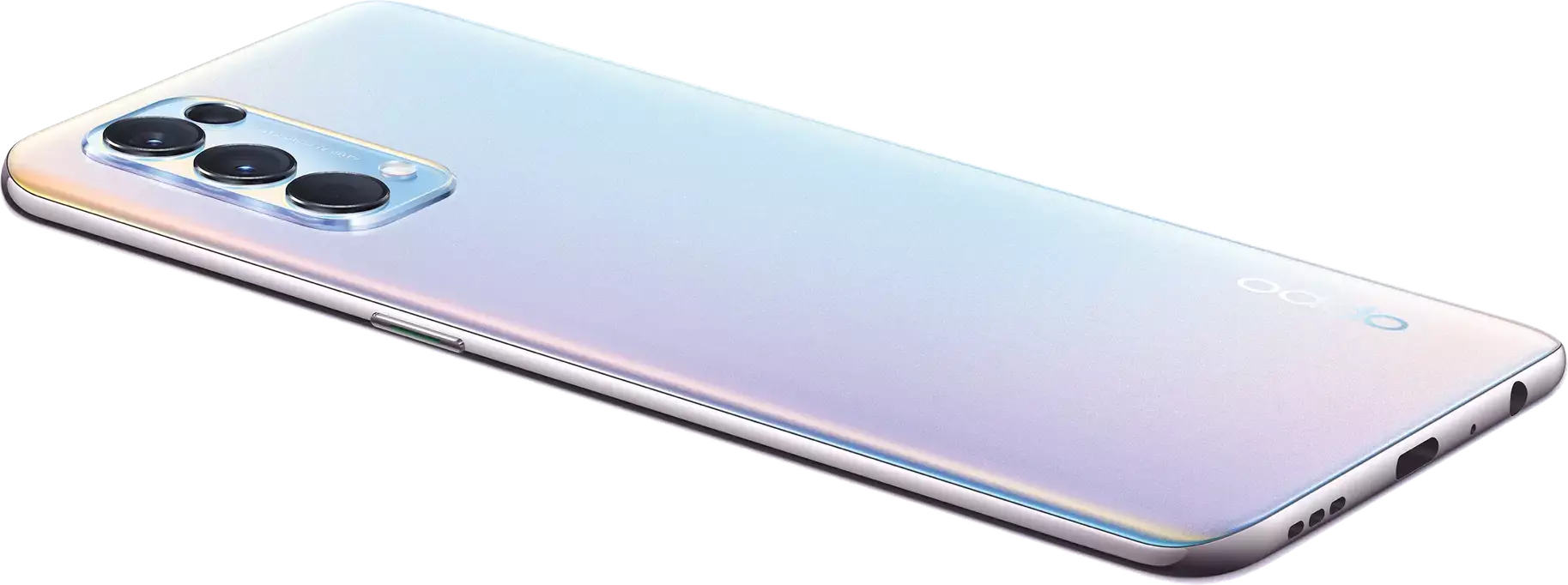

Oppo Reno5 Full Specifications and Price in United States, Europe and United Kingdom:
| First Release | January 9, 2020 |
| Colors | Black, Silver |
| Connectivity | |
|---|---|
| Network | 2G, 3G, 4G |
| SIM | Dual Nano SIM |
| WLAN | dual-band, Wi-Fi direct, Wi-Fi hotspot |
| Bluetooth | v5.0, A2DP, LE, aptX HD |
| GPS | A-GPS, GLONASS, GALILEO, QZSS, BDS |
| Radio | |
| USB | v2.0 |
| OTG | Yes |
| USB Type-C | Yes |
| Body | |
| Style | Punch-hole |
| Material | Gorilla Glass 3 front, plastic body |
| Water Resistance | ✖ |
| Dimensions | 159.1 x 73.3 x 7.7 millimeters |
| Weight | 171 grams |
| Display | |
| Size | 6.43 inches |
| Resolution | Full HD+ 1080 x 2400 pixels (409 ppi) |
| Technology | AMOLED Touchscreen |
| Protection | Corning Gorilla Glass 3 |
| Features | 90Hz refresh rate, 600 nits max. brightness |
| Back Camera | |
| Resolution | Quad 64+8+2+2 Megapixel |
| Features | PDAF, LED flash, 119º ultrawide, depth, macro & more |
| Video Recording | Ultra HD (2160p), gyro-EIS, HDR |
| Front Camera | |
| Resolution | 44 Megapixel |
| Features | F/2.4, HDR & more |
| Video Recording | Full HD (1080p), gyro-EIS |
| Battery | |
| Type and Capacity | Lithium-polymer 4310 mAh (non-removable) |
| Fast Charging | 50W SuperVOOC Fast Charging |
| Reverse Charging | Yes |
| Performance | |
| Operating System | Android 11 (ColorOS 11.1) |
| Chipset | Qualcomm Snapdragon 720G (8 nm) |
| RAM | 8 GB |
| Processor | Octa core, up to 2.3 GHz |
| GPU | Adreno 618 |
| Storage | |
| ROM | 128 (UFS 2.1) |
| MicroSD Slot | Dedicated slot |
| Sound | |
| 3.5mm Jack | Yes |
| Features | Loudspeaker |
| Security | |
| Fingerprint | In-display (optical) |
| Face Unlock | Yes |
| Others | |
| Notification Light | |
| Sensors | Fingerprint, Accelerometer, Gyroscope, Proximity, E-Compass |
| Manufactured by | Oppo |
Oppo Reno5 Price in United States, Europe and United Kingdom:
| United States | $ 300.00 |
| Europe | € 350.00 |
| United Kingdom | £ 300.00 |




The Oppo Reno5 is a stylish and powerful smartphone that combines cutting-edge technology with a sleek design. With a large 6.5-inch AMOLED display, you can enjoy vibrant colours and crisp visuals whether you’re streaming videos, gaming, or browsing social media. The phone is powered by a robust Qualcomm Snapdragon 765G processor and 8GB of RAM, ensuring seamless performance and efficient multitasking.
The Oppo Reno5 also boasts an impressive quad-camera system, featuring a 48MP primary camera, a 13MP telephoto lens, an 8MP wide-angle lens, and a dedicated 2MP monochrome camera. With advanced features such as optical zoom, portrait mode, and night mode, you can capture professional-quality photos and videos with ease. With a long-lasting 4500mAh battery and fast charging capabilities, you won’t have to worry about running out of juice throughout the day.
Other notable features of the Oppo Reno5 include an in-display fingerprint sensor, facial recognition, and Dolby Atmos sound enhancement. Running on ColorOS 7.2 based on Android 11, this smartphone offers a user-friendly interface and intuitive navigation. With its slim profile, rounded edges, and elegant finishes, the Oppo Reno5 exudes style and sophistication, making it a standout among other smartphones in its class. Whether you’re a tech enthusiast, a photography buff, or just someone looking for a reliable and stylish smartphone, the Oppo Reno5 is definitely worth considering.
Disclaimer: We can not guarantee that the information on this page is 100% correct. Read more
FAQ:
- Display: The screen display is one of the most important parts of a smartphone. It shows the user interface, apps, photos, videos, and other visual content. Displays come in different sizes, resolutions, and technologies such as LCD, OLED, AMOLED, and Retina.
- Processor: The processor is the brain of a smartphone. It handles all the calculations, operations, and tasks that the phone performs. Popular smartphone processors include Qualcomm Snapdragon, Apple A-series, and Huawei Kirin.
- RAM (Random Access Memory): RAM temporarily stores data and applications that the processor uses. More RAM means faster performance, smoother multitasking, and better gaming experience. Most smartphones have at least 4GB of RAM, but some high-end models offer up to 16GB or more.
- Storage: Smartphones have internal storage where the operating system, apps, photos, videos, and other files are stored. Some phones also have expandable storage via microSD cards. Common storage capacities range from 16GB to 512GB.
- Camera: Smartphone cameras have improved significantly over the years, offering advanced features like optical zoom, portrait mode, night mode, and video recording in 4K or higher resolution. Front cameras are typically used for selfies and face recognition.
- Battery: The battery life of a smartphone depends on various factors like screen size, processor, usage patterns, and software optimization. Many smartphones now support fast charging, wireless charging, or both. Battery capacities usually range between 2000mAh and 5000mAh.
- Operating System: The operating system manages the hardware and software resources of a smartphone. Popular smartphone OSes include Android, iOS, and Windows. Each has its unique features, app ecosystem, and user interface.
- Connectivity: Smartphones often feature multiple connectivity options like Wi-Fi, Bluetooth, NFC, GPS, and cellular networks (e.g., 4G, 5G). These allow users to access the internet, pair devices, navigate, and communicate with others.
- Audio: Smartphones may have speakers, earpieces, or headphones for audio output. Some phones also have specialized audio chipsets for enhanced sound quality or noise cancellation.
- Sensors: Various sensors inside smartphones enable features like fingerprint scanning, facial recognition, accelerometer, gyroscope, proximity detection, and ambient light measurement. These enhance user experience, security, and functionality.
- Durability: Smartphones are made with materials like glass, metal, or plastic. Some phones have IP ratings for dust and water resistance, which protect against accidental exposure to liquids or solid particles.
- Charging port: Smartphones require charging ports to replenish their batteries. Common charging ports include USB-C, Lightning (for iPhones), and Micro-USB (less common nowadays). Wireless charging pads or stands eliminate the need for cables.
- Buttons and controls: Physical buttons and touch controls facilitate navigation and operation. Common buttons include power, volume, and camera shutter release. Some phones use on-screen navigation keys or gesture-based interfaces.
- Antennas: Smartphones contain antennas for cellular communication, GPS, and Wi-Fi. They may be located at the top or bottom edges, or integrated into the device’s body.
- Fingerprint reader: Many smartphones feature fingerprint readers for biometric authentication. These can be physical buttons or optical scanners embedded under the display. Face ID systems are also becoming popular alternatives.